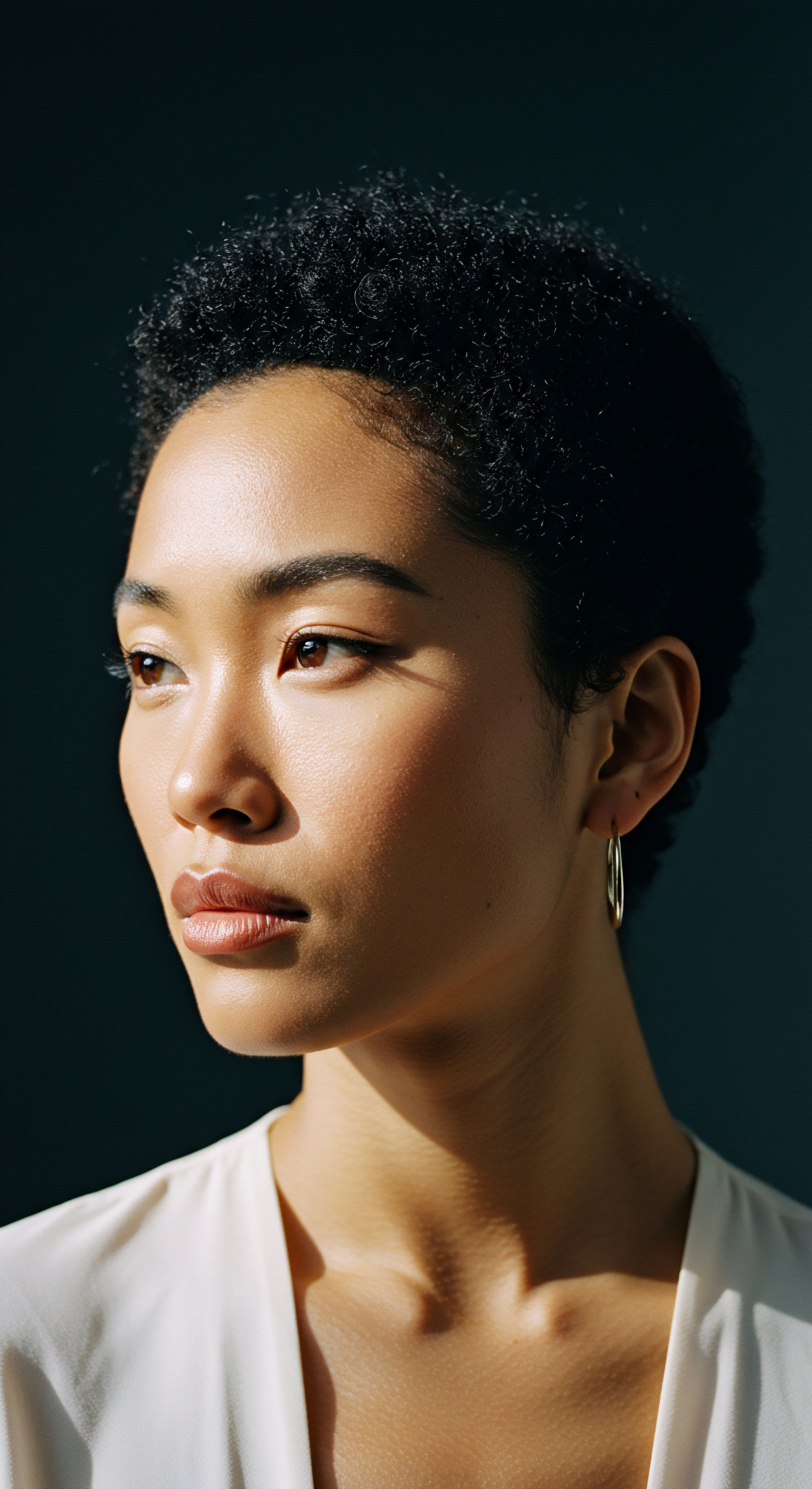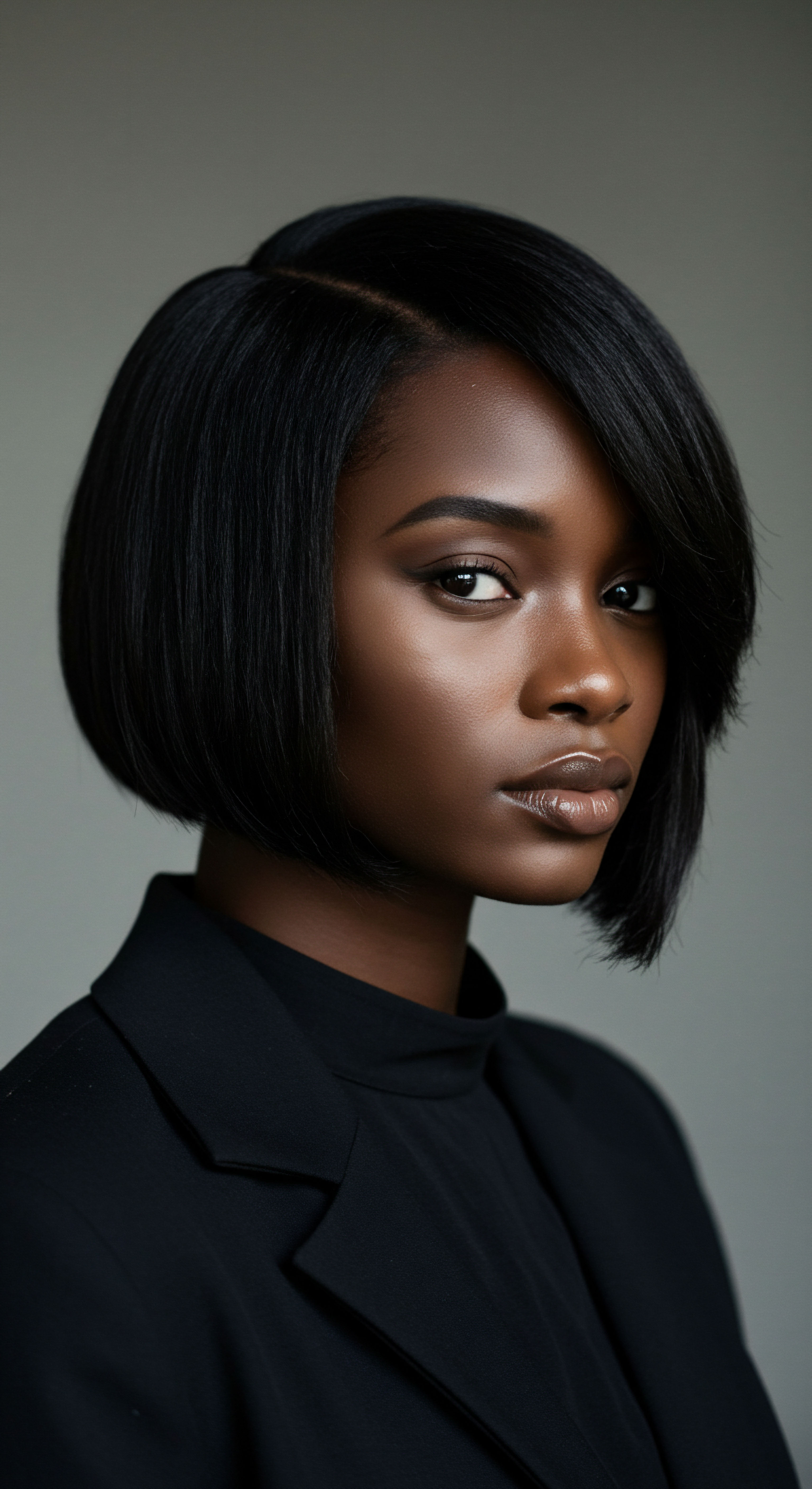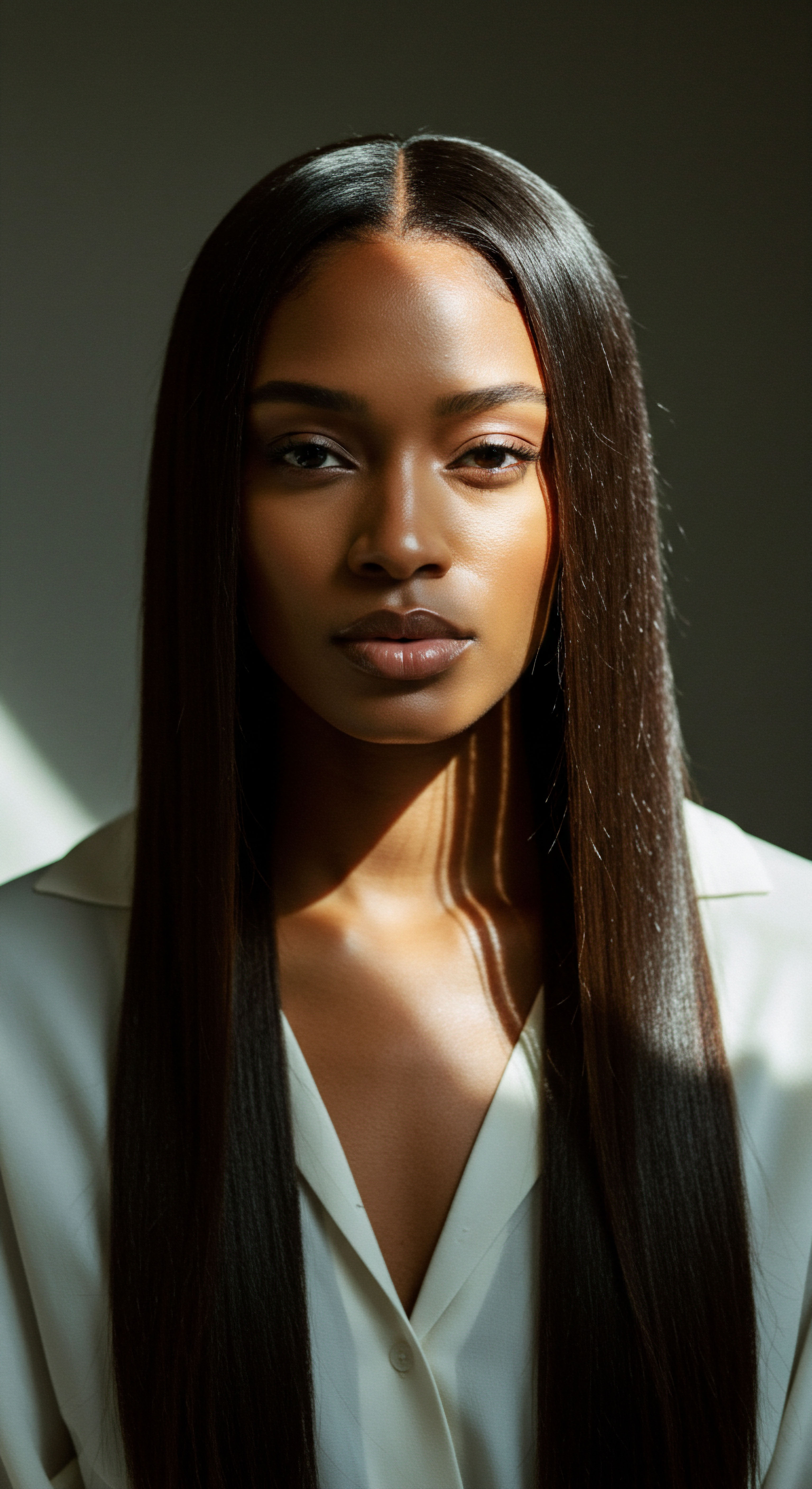
Roots
Beneath the surface of every coil, every ripple, every unique curl, lies a quiet, unseen world of delicate chemistry. Our hair, a living testament to personal heritage and style, holds secrets within its very structure, secrets whispered in the language of molecules and pH. For those of us with textured hair, this chemical conversation is particularly resonant, often dictating the very feel and appearance of our strands.
It’s a dance between nature’s design and the transformations we sometimes seek, a subtle equilibrium that, when disrupted, can lead to unforeseen consequences. Understanding this fundamental balance, especially as it relates to chemical treatments, provides a grounding presence for all hair journeys.

The Hair’s Natural State and Its Acidic Veil
At its healthiest, human hair exists in a slightly acidic environment. This delicate balance, often referred to as the hair’s acid mantle, shields the strands from external aggressors. The scalp itself maintains a pH around 5.5, while the hair shaft leans a bit more acidic, typically around 3.67 to 5.5.
This acidic cloak keeps the outermost layer of the hair, the cuticle, lying flat and smooth. When the cuticle scales are neatly closed, they act as a protective barrier, holding moisture within the hair’s core and reflecting light, resulting in a healthy sheen.
Consider the hair shaft as a miniature fortress. The cuticle, like overlapping shingles on a roof, forms the outer defense. Beneath this, the cortex, the hair’s central stronghold, provides its strength, elasticity, and color. The cortex is primarily composed of a protein called Keratin, a robust fibrous material.
These keratin molecules are held together by various bonds, among them the strong Disulfide Bonds, which are particularly responsible for hair’s natural curl pattern and its resilience. Hydrogen bonds and ionic bonds also play roles, though they are more susceptible to temporary changes from water or pH shifts.
Healthy hair thrives in a slightly acidic state, with its cuticle scales lying flat to preserve moisture and integrity.

What is PH Anyway?
The term pH, short for “potential of hydrogen,” quantifies the acidity or alkalinity of a substance. The pH scale spans from 0 to 14. A value of 7 marks neutrality, like pure water. Numbers below 7 indicate increasing acidity, meaning a higher concentration of hydrogen ions.
Values above 7 signify increasing alkalinity, reflecting a greater presence of hydroxide ions. For hair, maintaining its natural slightly acidic range is paramount. Deviations, particularly towards the alkaline side, can prompt the cuticle scales to lift, leaving the hair vulnerable.
Understanding this foundational chemistry prepares us to consider how various external factors, especially the potent agents found in chemical hair treatments, interact with our hair’s delicate internal environment. Each alteration, whether for straightening, curling, or coloring, begins with a shift in this crucial pH balance, setting a chain of events into motion that redefines the hair’s structure and its well-being.

Ritual
The desire to transform one’s hair, to reshape its natural inclination, has been a human ritual for centuries. From ancient practices to modern salon techniques, the act of altering hair goes beyond mere aesthetics; it is a declaration, a connection to identity, or a response to prevailing beauty standards. When we consider chemical treatments, we are stepping into a realm where science meets personal expression, where the very bonds that define a curl are deliberately, though often temporarily, reimagined. This section delves into how these processes, while offering desired visual changes, inherently interact with and adjust the hair’s pH, setting the stage for its new form.

Altering Hair’s Structure with Chemical Agents
Chemical treatments operate by strategically altering the hair’s internal bonds, particularly the disulfide bonds that give hair its inherent shape and strength. To access these bonds, the hair’s protective cuticle layer must first be opened. This is primarily achieved through the introduction of alkaline solutions, which cause the cuticle scales to swell and lift.
- Relaxers ❉ These treatments aim to permanently straighten curly or coily hair. Lye relaxers, containing sodium hydroxide, are highly alkaline, with pH levels ranging from 12.5 to 14.0. This extreme alkalinity rapidly breaks the disulfide bonds, allowing the hair to be reshaped into a straight form. No-lye relaxers, using ingredients like calcium hydroxide or guanidine carbonate, are somewhat milder, typically with a pH between 9.0 and 11.0. While less caustic to the scalp, no-lye relaxers can sometimes leave mineral deposits that may lead to dryness.
- Permanent Waves (Perms) ❉ Conversely, perms are designed to add curl or wave to straight hair. They use alkaline solutions, often containing ammonium thioglycolate, which penetrate the hair and break a percentage of the disulfide bonds. The hair is then wrapped around rods to create the desired curl pattern. After the bonds are broken and the hair is shaped, a neutralizer, typically an acidic solution like hydrogen peroxide, is applied to re-form the disulfide bonds in their new configuration, setting the curl.
- Hair Color ❉ The pH of hair coloring products varies based on their type and purpose.
- Temporary and Semi-Permanent Colors ❉ These generally have a less alkaline or even acidic pH (around 4.5-5.5 for acidic semi/demi-permanent, 6.5-8.0 for others). They deposit color molecules primarily on the hair’s surface or just inside the cuticle, causing less swelling.
- Demi-Permanent Colors ❉ With a pH around 6.0-8.0, these swell the hair just enough for color to penetrate slightly deeper into the cuticle.
- Permanent Hair Dyes and Bleaches ❉ These are highly alkaline, with pH levels ranging from 8.0 to 11.0, and sometimes even higher for bleaches. This high alkalinity is necessary to significantly lift the cuticle and allow the color molecules or lightening agents (like hydrogen peroxide and ammonia in bleach) to reach and alter the melanin within the cortex. This process can lead to significant protein degradation and increased porosity.
- Keratin Smoothing Treatments ❉ These treatments aim to reduce frizz and smooth the hair, often without permanently altering the curl pattern as drastically as relaxers. Many modern keratin treatments use acidic formulations, typically with a pH between 3 and 4. These acidic solutions help to smooth and seal the cuticle, locking in moisture and the keratin proteins, rather than breaking disulfide bonds in the same manner as alkaline relaxers or perms. Some older or stronger formulations might involve a higher pH clarifying shampoo at the start (pH 8-9 for ethnic, dense hair) to open the cuticle, followed by acidic treatment.
Each of these processes involves a deliberate, significant shift in the hair’s pH. This alteration is the chemical key that unlocks the hair’s structure, allowing for its transformation. The immediate impact is visible, but the lasting implications for the hair’s pH balance and overall health warrant deeper consideration.
Chemical treatments intentionally shift hair’s pH, often to alkaline levels, to open the cuticle and alter its structure for straightening, curling, or coloring.
The journey through chemical transformation is a testament to our ongoing relationship with self-presentation. It’s a journey where the unseen chemical reactions hold as much weight as the visible outcome, shaping the very resilience and vitality of our hair long after the salon visit.
| Treatment Type Lye Relaxers |
| Typical PH Range 12.5 – 14.0 |
| Primary Action on Hair Breaks disulfide bonds, permanently straightens. |
| Treatment Type No-Lye Relaxers |
| Typical PH Range 9.0 – 11.0 |
| Primary Action on Hair Breaks disulfide bonds, straightens with less scalp irritation. |
| Treatment Type Permanent Waves (Perms) |
| Typical PH Range 8.0 – 9.5 (Alkaline waving solution) |
| Primary Action on Hair Breaks disulfide bonds, reshapes hair into curls. |
| Treatment Type Permanent Hair Color/Bleach |
| Typical PH Range 8.0 – 11.0 (or higher for bleach) |
| Primary Action on Hair Lifts cuticle, alters melanin in cortex. |
| Treatment Type Demi-Permanent Hair Color |
| Typical PH Range 6.0 – 8.0 |
| Primary Action on Hair Swells cuticle slightly, deposits color. |
| Treatment Type Acidic Keratin Treatments |
| Typical PH Range 3.0 – 4.0 |
| Primary Action on Hair Seals cuticle, smooths hair, reduces frizz. |
| Treatment Type Understanding these pH shifts helps in predicting the immediate and potential long-term effects on hair health. |

Relay
Beyond the immediate gratification of a transformed texture or a vibrant new shade, the story of chemical treatments on curly hair extends into a complex interplay of science, heritage, and ongoing care. The pH shifts initiated during these processes set off a series of reactions that reverberate through the hair’s structure, influencing its long-term health and requiring a nuanced approach to its subsequent needs. This section delves into the deeper, often less visible, consequences of these chemical alterations, grounding our understanding in both scientific findings and the lived experiences of those with textured hair.

The Long-Term Repercussions of PH Imbalance
When hair is subjected to highly alkaline chemical treatments, its naturally protective acidic state is severely compromised. This extreme alkalinity forces the cuticle scales to lift excessively, sometimes even detaching or degrading, exposing the vulnerable cortex beneath. This compromised cuticle barrier means the hair struggles to retain moisture, leading to dryness, increased porosity, and a rougher feel. Moreover, the very protein structure of keratin can be degraded by high pH levels, diminishing the hair’s inherent strength and elasticity.
A study published in the International Journal of Trichology in 2014, examining the effects of varying pH levels on hair structure, revealed that alkaline pH levels (above 8) significantly increased the negative electrical charge on the hair fiber surface. This increased charge, in turn, led to greater friction between individual hair fibers, a direct contributor to frizz, tangling, and ultimately, mechanical damage. This scientific observation underscores a daily reality for many with chemically treated textured hair ❉ the persistent battle against frizz and the increased susceptibility to breakage, which are not merely cosmetic issues but symptoms of a fundamental structural alteration at the microscopic level.

What Happens to the Hair’s Internal Bonds?
The disulfide bonds, those strong anchors of hair’s natural curl, are the primary targets of many chemical treatments. Relaxers, for instance, break these bonds permanently, preventing them from reforming in their original curly configuration. While perms also break and then re-form these bonds in a new shape, the process itself, and the subsequent need for neutralizing agents, places considerable stress on the hair. Repeated chemical interventions can lead to a cumulative weakening of the hair’s internal structure, making it more fragile and prone to damage over time.

Why Do Neutralizers and Post-Treatment Care Matter?
Following highly alkaline treatments like relaxers or perms, the hair is left in a highly alkaline state, with open cuticles and compromised internal bonds. This is where acidic neutralizing shampoos and conditioners become indispensable. These products are formulated with mild acids, such as citric or lactic acid, with a pH typically between 4.5 and 5.5. Their purpose is to:
- Restore PH Balance ❉ They swiftly bring the hair and scalp back to their natural acidic pH range, halting any lingering chemical reactions.
- Seal the Cuticle ❉ The return to an acidic environment causes the lifted cuticle scales to flatten and close, trapping moisture inside and restoring smoothness.
- Re-Form Bonds ❉ In the case of perms, the neutralizer specifically re-forms the disulfide bonds in their new shape, making the curl permanent. For relaxers, while the primary bonds are permanently altered, neutralizing helps stabilize the hair’s overall condition.
Neglecting this crucial neutralization step can leave the hair in a chronically alkaline state, making it continuously vulnerable to damage, dryness, and a dull appearance.
The consistent return to hair’s natural acidic pH after chemical treatments is a vital step in maintaining its long-term health and resilience.

The Cultural Echoes of Hair Transformation
The discussion of chemical treatments and pH would be incomplete without acknowledging the rich and often complex cultural context, particularly within Black and mixed-race communities. For generations, chemical relaxers, often referred to by the powerful and sometimes controversial term “creamy crack,” represented a pathway to assimilation and societal acceptance in environments that historically favored straight hair textures. The invention of the chemical relaxer by Garrett A.
Morgan Sr. in 1909, and its subsequent widespread adoption, reflects a period where hair texture was deeply intertwined with social mobility and perceived beauty standards.
While the natural hair movement has gained significant momentum, celebrating and preserving textured hair in its unaltered state, the legacy of chemical treatments persists. For some, they remain a choice of style and convenience. For others, the historical pressures that led to their widespread use continue to resonate.
The long-term health of chemically treated hair, particularly concerning pH balance and structural integrity, carries not only scientific implications but also a historical weight, prompting conversations about self-acceptance, beauty ideals, and informed hair care choices. This cultural lens reminds us that hair science is never purely clinical; it is deeply human.

Reflection
As we consider the profound impact of chemical treatments on the pH of curly hair, a deeper appreciation for the delicate balance within our strands comes into focus. Each choice we make for our hair, whether it is to alter its natural curl or to maintain its inherent texture, sends ripples through its very structure. Understanding the unseen world of pH, the lifting of cuticles, and the re-forming of bonds, allows us to approach hair care not as a series of rigid rules, but as an ongoing conversation with our hair’s unique chemistry and history. It is a dialogue that calls for attentiveness, informed decisions, and a gentle hand, ensuring that our hair, in all its varied forms, continues to tell its vibrant story with strength and well-being.

References
- Atlas Scientific. (2024). The Importance Of pH In Hair Products.
- IS MUNI. (n.d.). The Chemistry of Perming & Rebonding.
- Redken. (n.d.). What Is Hair pH? Why Is pH Important for My Hair?
- Kera Mane. (2024). Understanding the pH of Keratin Treatments ❉ How pH Levels Impact Your.
- Hair Colour for Hairstylists ❉ Level 2. (n.d.). 1.3 How Does Hair Colour Work?
- Refinery29. (2021). The Evolution Of The Natural Hair Movement.
- Hassan, R. et al. (2024). Investigation of the Changes in the Hair Cuticle Due to Chemical Degradation. Uttar Pradesh Journal of Zoology, 45(2), 86-94.
- WhiteLotusHairStudio. (n.d.). Black Hair History.
- Style by Louis. (2023). A Comprehensive Guide to Understanding Different Types of Hair Dyes.
- Couture Hair Pro. (2023). What is Neutralizing Shampoo? Complete Guide.
- Kera Mane. (2024). Keratin Treatment ❉ Step-by-Step Protocol for the Procedure.
- Cosmo Service Italy. (2018). Perm Neutralizer.
- KERATINWORKS. (2023). The Science Behind Keratin Smoothing Treatments.
- HONESTLIZ. (2022). Why pH Value of Curly Hair is Important.
- Curly Selection. (n.d.). Damaged Hair ❉ Keratin, Disulfide Bonds and Olaplex.
- Hilaris Publisher. (2024). Evaluating the Long-term Outcomes of Chemical Hair Treatments on Hair Structure and Scalp Health.
- CheMondis Blog. (2024). The Hidden Chemistry of Sodium Hydroxide in Hair Care Products.
- Brainly. (2024). An acid-balanced neutralizing shampoo or stabilizer is used after the hair is free of chemicals to ❉ A.
- K18 Hair PRO. (n.d.). Everything You Need to Know About pH + Hair.
- Melcurls. (2020). HAIR PH BALANCE, SCALP HEALTH.
- ResearchGate. (n.d.). Preparation of Demipermanent and Semipermanent Hair Dyes Gels from Ethanol Extract of Caesalpinia sappan L. using Carbomer as Gelling Agent.
- Blue Nectar. (2021). Why Hair Care Products Aren’t Working for You? Check pH of Hair and Scalp.
- Smiths Collective Brands. (2025). The Impact of pH on Hair Health and How to Restore Balance with Professional Haircare, Featuring REF.
- K18 Australia. (2022). How Do pH Levels in Hair Care Products Affect Your Hair.
- Monpure. (2023). Why pH is so Important for Scalp and Hair Health.
- Sanft & Schön. (n.d.). Understanding Your Hair Cortex ❉ Key to Healthy Hair.
- Wikipedia. (n.d.). Keratin.
- Design Essentials. (n.d.). Knowing Different Types of Hair Relaxers.
- Hairlicious Inc. (2017). Hair Question ❉ Lye vs. No Lye Relaxer – The Difference + Pros and Cons.
- Philip Kingsley. (2022). Hair Biology & Bonds.
- Allison McTigue Salon. (2023). What is Hair pH & Why it’s Important?
- ResearchGate. (n.d.). Insights into Structural and Proteomic Alterations Related to pH-induced Changes and Protein Deamidation in Hair.